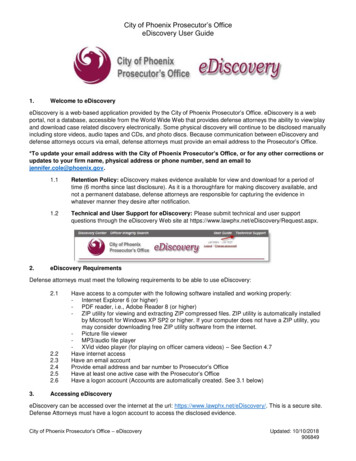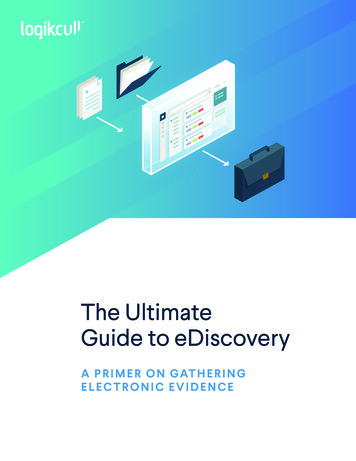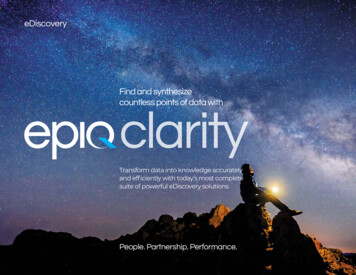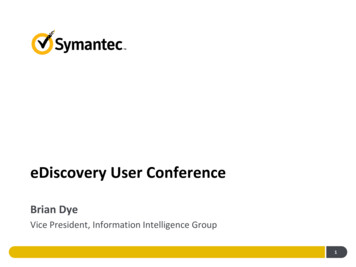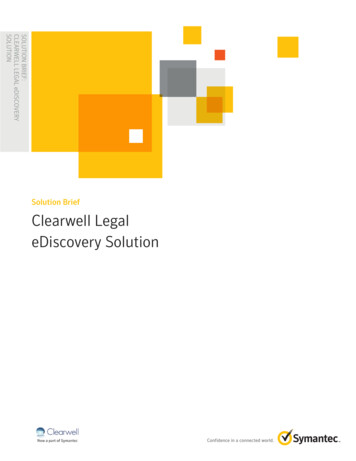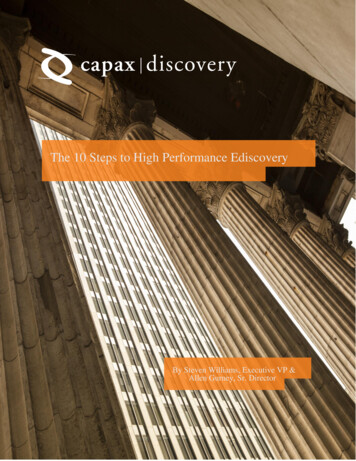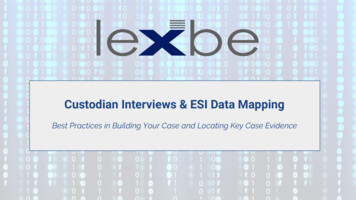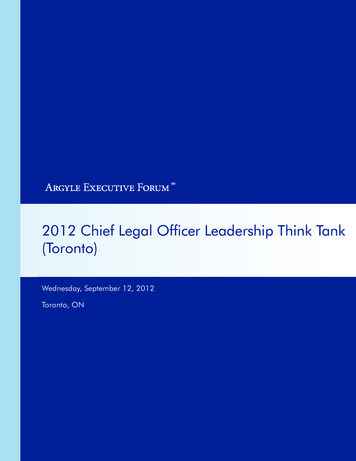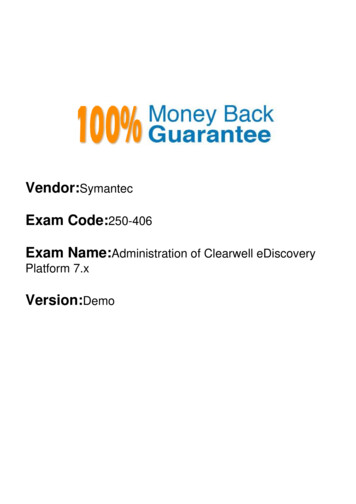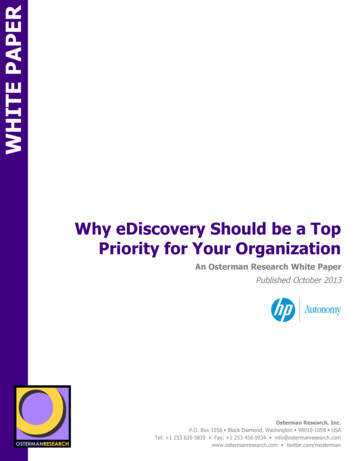
Transcription
WHITE PAPERWhy eDiscovery Should be a TopPriority for Your OrganizationONAn Osterman Research White PaperPublished October 2013!!SPON!sponsored bysponsored byOsterman Research, Inc.P.O. Box 1058 Black Diamond, Washington 98010-1058 USATel: 1 253 630 5839 Fax: 1 253 458 0934 info@ostermanresearch.comwww.ostermanresearch.com twitter.com/mosterman
Why eDiscovery Should be aTop Priority for YourOrganizationEXECUTIVE SUMMARYeDiscovery is a critical process that occurs early in civil litigation matters and involvesthe exchange of information between parties involved in a lawsuit or some other legalaction. eDiscovery has implications for a variety of activities, including the archival ofelectronic information, the ability to search for relevant content, the ability to modifycontent deletion policies, how storage systems are managed, how corporate policiesare developed and risk management.The importance of eDiscovery should not be underestimated: it is among the primarydrivers for the deployment of archiving systems and has significant implications forhow organizations retain, store and manage their electronic content. A failure tomanage eDiscovery properly can carry with it serious ramifications. Moreover, theproblem of eDiscovery is expected to become more serious as evidenced by thegrowing number of eDiscovery requests that are anticipated over the next 12 months.Figure 1Anticipated Change in the Number of eDiscovery RequestsSeptember 2013 to September 2014The importanceof eDiscoveryshould not beunderestimated:it is among theprimary driversfor thedeployment ofarchiving systemsand hassignificantimplications forhow organizations retain,store andmanage theirelectroniccontent.KEY TAKEAWAYSThere are three important issues that decision makers should consider: eDiscovery is an important issue and is becoming more serious over time, butmost corporate decision makers believe they are not as well prepared for it asthey should be. Most organizations have at least partially addressed eDiscovery issues focused onemail, but a growing number of data types and venues are complicating theproblems of eDiscovery and content management in general. eDiscovery rules and requirements continue to evolve and are placing additionaldemands on decision makers to manage eDiscovery properly.ABOUT THIS WHITE PAPERThis white paper includes data from a survey conducted by Osterman Researchspecifically for this white paper during September 2013, as well as other OstermanResearch survey data generated during 2013. This white paper was sponsored by HPAutonomy - relevant information about the company and its offerings are provided atthe end of this document. 2013 Osterman Research, Inc.1
Why eDiscovery Should be aTop Priority for YourOrganizationWHAT IS CHANGING IN eDISCOVERY?DISCOVERY AND eDISCOVERY DEFINEDDiscovery can be viewed in a couple of ways: first, as a relatively strict set ofrequirements focused on searching for content that may be relevant for use asevidence in a trial or in pre-litigation activities. Viewed in this way, it can include anysort of document or other information that might be useful to prove a plaintiff’s ordefendant’s case in a civil action. Viewed more broadly, however, discovery can beconsidered the ability to search for content not only within the relatively strictconfines of court-ordered discovery activities, but also all of the efforts focused onfinding content that might somehow be relevant in the context of any litigationrelated activity, such as senior managers performing informal early case assessmentsor departmental managers searching for potentially damaging content in theiremployee’s communication or collaboration streams.“eDiscovery” is merely the extension of the well-established discovery process to anyElectronically Stored Information (ESI) that an organization might possess – emailmessages, voicemails, presentations, word processing files, spreadsheets, tweets,Facebook posts and all other relevant communication or information that might beuseful in a legal action. eDiscovery can extend to any platform on which ESI isstored: servers, desktop computers, laptops, smartphones, tablets, backup tapes, andeven employees’ home computers and other personally owned devices.AN ESSENTIAL ACTIVITYeDiscovery is an essential element of any organization’s information managementstrategy because of the significant implications that can result from poor eDiscovery.This is a reality that has not been lost on organizational decision makers – as shownin the following figure, the ability to perform eDiscovery on email is nearly asimportant as the ability to satisfy regulatory data retention obligations and the abilityto manage email storage more effectively. Moreover, the ability to performeDiscovery on other content types, such as social media (whether public tools likeFacebook or Twitter, or enterprise focused) and files, is also viewed as highlyimportant by a significant proportion of organizational decision makers.eDiscovery is anessential elementof igure 2Importance of Key Information Management Capabilities% Responding Important or Extremely Important 2013 Osterman Research, Inc.2
Why eDiscovery Should be aTop Priority for YourOrganizationIMPORTANCE AND READINESS ARE AT ODDSIn contrast to the perceived importance of eDiscovery is the relative lack ofpreparedness for it that our research found among various groups. For example, asshown in the following figure, internal legal counsel perceives eDiscovery to be ofsignificant importance – 75% of legal counsel believes that it is important orextremely important – but a much smaller proportion of internal legal counselconsiders themselves to be well prepared or very well prepared to manageeDiscovery. While we find a similar disparity between senior, non-IT managers, ITmanagement has the smallest disparity between the importance it places oneDiscovery and its preparedness for it.Figure 3Importance of and Preparedness for eDiscovery by Various Groups% Responding Important or Extremely Important% Responding Well Prepared or Very Well PreparedFor conventional, non-emaildata like files,preparedness foreDiscovery isrelatively poor.In the context of how ready organizations are for eDiscovery, our research also founda significant disparity of organizational preparedness based on the types of data thatmight be required for eDiscovery. As shown in the following figure, 85% oforganizations consider themselves to be well prepared or very well prepared toconduct eDiscovery on email that is up to a month old, although preparedness todiscover email falls significantly as email ages.For conventional, non-email data like files, preparedness for eDiscovery is relativelypoor, with only about one-half of organizations indicating they are prepared toconduct eDiscovery on files, despite the fact that other Osterman Research surveyshave found that the largest single type of discoverable data is contained in files. Withregard to other data types, preparedness for eDiscovery is quite poor, with only afraction of organizations reporting that they are ready to conduct eDiscovery on thesedata types. 2013 Osterman Research, Inc.3
Why eDiscovery Should be aTop Priority for YourOrganizationFigure 4Preparedness for Various eDiscovery-Related Activities% Responding Well Prepared or Very Well PreparedThe enormousscale and growthof ESI clearlyillustrates theproblem thatorganizationshave, and willhave, in findingand producingESI.ELECTRONIC DATA VOLUMES ARE GROWING RAPIDLYOrganizations of all sizes generate an enormous amount of digital information. Forexample, the IDC Digital Universe study published in December 2012 estimated that2.8 zettabytes (2.8 trillion gigabytes) of information were created and replicatedduring 2012, a dramatic increase from 2006 and a 56% increase from just 2011i. Addto this the fact that IBM estimates that every day 2.5 quintillion bytes of data arecreatedii.While a significant proportion of this data is normally not the focus of eDiscovery, theenormous scale and growth of ESI clearly illustrates the problem that organizationshave, and will have, in finding and producing ESI. As a simple illustration of datagrowth, the figure on the following page demonstrates the growth of content storagein an organization with just 1,000 email users. 2013 Osterman Research, Inc.4
Why eDiscovery Should be aTop Priority for YourOrganizationFigure 5Archiving Requirements for a 1,000-Person Company Over Seven YearsGigabytes of Content StorageThe Civil RulesAdvisoryCommittee hasoffered a numberof amendmentsto the FRCP that,if accepted, willgo into effect onDecember 1,2015.PRIMARY DRIVERS FOR eDISCOVERYTHE FEDERAL RULES OF CIVIL PROCEDUREThe Federal Rules of Civil Procedure (FRCP), established in 1934, are a set of rulesthat are focused on governing procedures for managing civil lawsuits in the UnitedStates district courts. The United States Supreme Court is responsible for overseeingthe FRCP, but the United States Congress must approve these rules and any changesmade to them.A variety of important changes to the FRCP went into effect in December 2006. Theseincluded an expansion of discoverable material to include all ESI that might berelevant in a legal action [Rule 26(a)]; a schedule conference to discuss eDiscoveryand other issues must be held within 120 days after a legal action is initiated [Rule16(b)]; the requirement that within 99 days after a legal action commences, theparties must come to an agreement about the protocols and procedures that willgovern the eDiscovery process [Rule 26(f)]; the rule that when a party requestsinformation as part of eDiscovery they can specify the format in which they would likeit to be provided [Rule 34(b)]; and the rule that sanctions can be avoided with thecourt’s blessing if ESI is lost because of good faith deletion practices that were notintended to destroy evidence [Rule 37(f)].UPCOMING CHANGES TO THE FRCPThe Civil Rules Advisory Committee has offered a number of amendments to theFRCP that, if accepted, will go into effect on December 1, 2015 unless Congressintervenes. Key elements of these amendments will include: Greater emphasis on cooperation between litigants focused on controlling theburden and expense of eDiscovery with particular emphasis on court-initiatedefforts to improve the level of cooperation between the parties. As part of thischange, Rule 16(b)(1) would be amended to provide for improvedcommunication for scheduling conferences, requiring that synchronouscommunication (face-to-face meetings, telephone calls, etc.) be used instead ofwritten correspondence or email. 2013 Osterman Research, Inc.5
Why eDiscovery Should be aTop Priority for YourOrganization An increased emphasis on the proportionality of discovery efforts with the goal oflimiting the scope of discovery. This includes limiting sanctions for failing topreserve content only if the lack of retention was “willful or in bad faith” and“caused substantial prejudice in the litigation” (with some exceptions). Part ofthis would include encouraging litigants to include preservation agreements aspart of the 26(f) conference. Increased specificity would be required when objecting to document requests,including the requirement that any objection must “state whether any responsivematerials are being withheld on the basis of that objection”. This would affectparts of Rule 34. Earlier production of content would be required, including halving the length oftime to serve defendants with a summons from 120 to 60 days.A good overview of the proposed amendments is available from a number ofsourcesiii.FEDERAL RULES OF EVIDENCEThe Federal Rules of Evidence (FRE), which have been in effect since 1975, are a setof requirements that focus on evidence presentation during trial in the US federalcourts. Individual US states may use these rules as the basis for their own rules ofevidence, or they can adopt a different set of requirements for presenting evidenceduring trial. For purposes of presenting evidence, a printed or otherwise humanreadable version of electronic evidence is considered to be an original and can bepresented at trial according to FRE Rule 1001(3).Authenticationfor electroniccontent is morecritical than forpaper-baseddocumentsbecauseelectronicdocuments aremore easilyaltered.Authentication is an essential component of the eDiscovery process because it isfocused on demonstrating that a document is what its presenter claims it to be – anactual and verifiable representation of an electronic document.Authentication for electronic content is more critical than for paper-based documentsbecause electronic documents are more easily altered. The process of copying datafrom one location to another can alter metadata, for example, and call into questionits authenticity. When the authenticity of evidence is challenged, this can create avariety of problems and can add to the expense of a legal actions. Atkinson-Baker hasdeveloped a good overview of the authentication requirements for electronicrecordsiv.A key ruling involving authenticity of electronic content is Lorraine v. Merkel, forwhich the chief magistrate presiding over the case wrote: “ there are five distinctbut interrelated evidentiary issues that govern whether electronic evidence will beadmitted into evidence at trial or accepted as an exhibit in summary judgmentpractice. Although each of these rules may not apply to every exhibit offered eachstill must be considered in evaluating how to secure the admissibility of electronicevidence to support claims and defenses. Because it can be expected that electronicevidence will constitute much, if not most, of the evidence used in future motionspractice or at trial, counsel should know how to get it right on the first try.Computerized data . raise unique issues concerning accuracy and authenticity .The integrity of data may be compromised in the course of discovery by impropersearch and retrieval techniques, data conversion, or mishandling.”RULES OUTSIDE OF THE UNITED STATESUS eDiscovery practices are perhaps more advanced and requirements more specificthan in most other nations owing largely to the more litigious nature of US societyrelative to other nations. This is evidenced by the relatively large number of attorneysper capita in the United States: for example, the United States has 265 residents perattorney compared to the United Kingdom with 401v. 2013 Osterman Research, Inc.6
Why eDiscovery Should be aTop Priority for YourOrganizationWhile eDiscovery (often referred to as “e-disclosure” outside of the United States) inUS legal proceedings can be difficult and expensive, laws in other parts of the worldcan present their own unique challenges. For example: Ontario amended its rules of civil procedure in 2010 so that it couldaccommodate the growth of electronic content as part of the discovery process.Rule 29.1.03(4) now reads “In preparing the discovery plan, the parties shallconsult and have regard to the document titled 'The Sedona Canada PrinciplesAddressing Electronic Discovery' developed by and available from The SedonaConference.” In most European nations litigants are not required to produce content that runscounter to the claims they make in a legal action. Requirements in the UnitedKingdom, however, can compel organizations to produce damaging content, butonly after a court ordervi. Courts in England and Wales can require some type of standard disclosure –namely, the disclosure that a document “exists or has existed”. The recipient ofthe disclosure has a right to inspection of the documents, albeit subject to avariety of restrictionsvii. However, in April 2013 the UK Civil Procedure Rule 31.5went into effect, permitting courts more discretion when ordering disclosure.Some of the rules in England and Wales are similar to the FRCP in the UnitedStates, such as the requirement to disclose relevant documents and theapplicability of the Rule to electronic contentviii. Mexico does not have pre-trial discovery or disclosure requirements, but thecourts can compel litigants and third parties to produce information if theydetermine it is necessary and if the documents are specifically identified. Australia’s Supreme Court of Victoria, in Practice Note No. 1 of 2007 (February2007), strongly suggested that the parties to a legal action should consider usingtechnology to improve the efficiency of legal proceedings, including eDiscoverytools. The Federal Court of Australia has developed eDiscovery rules similar tothose contained in the 2006 amendments to the FRCP. Moreover, the AustralianFederal Court ruled in 2009 that all cases meeting minimum requirements mustbe managed only with digital content and not via paper-based means. Various statutes designed to block discovery proceedings have been in place formany years in a number of countries. These statutes exist in Ontario, federalCanada (Business Records Protection Act), the United Kingdom (The Shippingand Commercial Documents Act) and the Netherlands (Economic CompetitionAct). The key issue with regard to blocking statutes is that even though data hasbeen found, it may not necessarily be usable.In mostEuropeannations litigantsare not requiredto producecontent that runscounter to theclaims they makein a legal action.LOCATION OF DISCOVERED DATA CAN ALSO BE AN ISSUEAdopted in October 1995, European Commission Directive 95/46/EC was designed tostandardize the protections for data privacy among EU member states and to protectindividuals’ rights to privacy. The Directive focuses on the processing of individuals’data held within the EU, but also applies to any entity outside of the EU to which datamight be provided, such as data shared during the eDiscovery process. A key elementof the Directive is that it does not permit data to be provided to any entity whosenational laws do not adequately protect privacy rights.Other noteworthy examples: France, with its somewhat unique legal system, imposes more stringentrequirements than Directive 95/46. French Penal Code, Law No 80 – 538 imposesfines and/or jail time for those who seek, request or disclose informationintended to develop evidence for foreign legal proceedings. 2013 Osterman Research, Inc.7
Why eDiscovery Should be aTop Priority for YourOrganization The Convention on the Taking of Evidence Abroad in Civil Matters (the HagueEvidence Convention), ratified by the U.S. Senate ratified in 1972, was designedto “establish a system for obtaining evidence located abroad that would be‘tolerable’ to the state executing the request and would produce evidence‘utilizable’ in the requesting state.”A useful analysis of eDiscovery outside of the United States is E-Discovery Around theWorldix.OBLIGATIONS FOR ALL ORGANIZATIONSA robust eDiscovery strategy should include several elements to ensure that it cansatisfy an organization’s litigation requirements and to minimize the risk of problemsduring legal actions. While these apply specifically to eDiscovery, the generalprinciples involved largely apply to satisfying regulatory obligations, as well: Litigation holds are keyA litigation hold requires the suspension of any content deletion processes orpractices before during a legal action. Because organizations must preserve allrelevant data when a legal action is reasonably anticipated, continuing to deletecontent after this point can result in serious consequences. Courts have thediscretion to impose a variety of sanctions, including fines, adverse inferenceinstructions to a jury, additional costs for third parties to review or search fordata, or even criminal charges. At a minimum, an organization that cannotproduce data as a result of deletion may suffer harm to its corporate reputation. Respond to requests rapidlyFRCP Rule 26(a)(1) requires that litigants have a good understanding of theirdata assets and that they are able to discuss these issues ahead of the initialpre-trial discovery meeting. Moreover, FRCP Rule 16(b) requires that thismeeting take place within 99 days from the commencement of a legal action,and so all parties must have solid eDiscovery capabilities in place prior tolitigation. In some cases, a court will require even more rapid production ofcontent. Identify content that can and cannot be accessedAll parties to civil litigation must determine the content that it can and cannotreasonably produce. If the evaluation determines that specific electronic contentcannot be provided because it is not accessible or would be too expensive toproduce, FRCP Rule 26(b)(2)(B) of the FRCP still requires that information aboutthis content must be made available. As just one example, information describingcontent on backup tapes that is in a format that can no longer be read mightneed to be made available. Manage a growing number of data types and venuesThe eDiscovery process is further complicated by the need to produce a largeand growing number of data types and platforms on which relevant data may bestored. For example, social media content from official, corporate accounts andpersonal accounts – if it contains business records that might be relevant duringlitigation – must be produced. Information on personally owned devices – whichare rapidly becoming the mobile platform of choice in many organizations – mustalso be produced even though it is on devices that often are not under directcorporate control.A litigation holdrequires thesuspension ofany contentdeletionprocesses orpractices beforeduring a legalaction.eDISCOVERY REQUIREMENTS AND COMMON MISTAKESThere are a number of lessons that decision makers can learn from court decisionsabout what to do – and what not to do – with regard to eDiscovery. Here are somenotable cases that can shed light on best practices when considering how to plan foreDiscovery: 2013 Osterman Research, Inc.8
Why eDiscovery Should be aTop Priority for YourOrganization eDiscovery must not be overly broadIn the 2010 case of Moulin Global Eyecare Holdings Ltd. v. KPMG, the courtrejected the plaintiffs’ arguments for a discovery request that it considered tooexpansive. The court determined that allowing such broad access to thedefendant’s electronic content would be “tantamount to requiring the defendantsto turn over the contents of their filing cabinets for the plaintiffs to rummagethrough.x” A failure to retain ESI can lead to sanctionsIn Pension Committee of University of Montreal Pension Plan v. Banc of AmericaSecurities, LLCxi, the Court issued sanctions against parties for not adequatelypreserving ESI, citing the “gross negligence” of their actions. This ruling occurredeven though the judge found no evidence of bad faith on the part of those whodid not retain the required ESI.In Frank Gatto v. United Air Lines, the plaintiff deleted his Facebook information,access to which had been requested by the plaintiffs. The court agreed with thedefendant’s motion and issued an adverse instructionxii. Backup tapes can create problems in eDiscoveryAs we have discussed many times in other reports, backups tapes are a poormethod for preserving discoverable content because extraction of this content ispotentially time-consuming, expensive and may not produce all of the requiredinformation. The case of Johnson v. Neimanxiii is a good example: the defendantargued that it should not have to produce emails that were stored on 5,880backup tapes because accessing this information would allegedly have required14,700 person-hours to catalog and restore, and that an additional 46.7 dayswould have been required for the creation of .PST files. Moreover, the defendantargued that this data was not reasonably accessible, a position with which theCourt agreed and did not require production of the data – fortunately for thedefendant. Agreement about discoverable content is essentialIn the case of Digicel v. Cable & Wireless PLC, the defendant made a decisionnot to search through their backup tapes for content without consulting theplaintiff. Moreover, the defendant determined the search terms it would use eventhough the plaintiffs did not agree with them. The UK court that heard the caseoverruled the defendant’s decision and ordered it to both restore employeeemails that were stored on backup tapes, as well as add additional searchterms.xiv Demonstration that appropriate material was usedMany organizations use social media content in the recruiting and candidateevaluation process. However, employers are limited in the types of content thatthey can evaluate in the hiring process and must not consider a candidate’s race,religion, sexuality or certain other types of information. If an employer usessocial media as part of the hiring process, it should archive the specific content itused about employment candidates to demonstrate that it did not evaluatematerial that could not be considered. A failure to do so – and an employer’sinability to demonstrate its good faith evaluation of this information duringeDiscovery – could result in serious consequences. Relevant regulations includethe Americans with Disabilities Act, the Age Discrimination in Employment Act,the Civil Rights Act of 1964 and Executive Order. No. 11,246xv. eDiscovery must be managed properlyIn the case of Green v. Blitz U.S.A.xvi , the Court sanctioned the defendant for avariety of failures, including not putting a legal hold on relevant data, notcoordinating the work of their representative with the defendant’s ITdepartment, and not performing keyword searches. The result was that relevantdocuments were not produced. Key documents were not discovered in this case,but were discovered in another case a year later. The result was a 250,000 civil 2013 Osterman Research, Inc.In Frank Gatto v.United Air Lines,the plaintiffdeleted hisFacebookinformation,access to whichhad beenrequested by theplaintiffs. Thecourt agreed withthe defendant’smotion andissued an adverseinstruction.9
Why eDiscovery Should be aTop Priority for YourOrganizationcontempt sanction against Blitz, an order to inform plaintiffs from the past twoyears about the sanction, and an order to include a copy of the sanctionmemorandum in every case in which it would be involved during the next fiveyears.SOCIAL MEDIA RAISES OTHER ISSUESSocial media has raised a number of issues in the context of litigation. Oneinteresting development has been the increasing acceptance of courts to allowprocess serving to occur via social networks. The first such case was permitted by anAustralian court in 2008 when legal documents in a foreclosure case were deliveredvia Facebook when conventional means of content delivery had proven to be fruitless.Courts in New Zealand, Singapore, Canada, the United Kingdom and in a few USstates followed suit and now many courts allow process serving to occur when moreconventional means of document delivery cannot be usedxvii.Another interesting use of social media is its use in the jury selection process. Forexample, in the case of Johnson v. McCullough that was adjudicated before theMissouri Supreme Court in 2010, the Court ruled that attorneys have an affirmativeduty to use online resources as a key component of the jury selection processxviii.THE ELECTRONIC DISCOVERY REFERENCE MODEL (EDRM)The Electronic Discovery Reference Model (EDRM), which was placed into the publicdomain in May 2006, was developed in response to the relatively few standards andlack of generally accepted guidelines for the process of eDiscovery that existed priorto its development. The team that developed the EDRM was facilitated by GeorgeSocha (Socha Consulting LLC) and Tom Gelbmann (Gelbmann & Associates), andincluded 62 organizations, among whom were software developers, law firms,consulting firms, professional organizations and large corporations.Social media hasraised a numberof issues in thecontext oflitigation.Figure 6Electronic Discovery Reference ModelxixThe EDRM is important because it represents a useful tool in the standardization ofthe eDiscovery process. Standardization is essential for eDiscovery because of thegrowth in the quantity and diversity of ESI, as well as the large number of entitiesthat will need to process this data during the normal course of eDiscovery.The EDRM XML project followed in the 2006-2007 timeframe. The goal of the projectwas to “provide a standard, generally accepted XML schema to facilitate themovement of electronically stored information (ESI) from one step of the electronicdiscovery process to the next, from one software program to the next, and from oneorganization to the next. The EDRM XML 2 project continued the development of theEDRM XML schema for metadata, developing protocols for the number of electronic 2013 Osterman Research, Inc.10
Why eDiscovery Should be aTop Priority for YourOrganizationfiles that are preserved in their native format, and developing a compliance validationtool, among other projects.ADDRESSING COSTS EARLY IN THE PROCESSA RAND Corporation studyxx found that 73% of the costs associated with producingelectronic documents were consumed by review-related activities, while 19% was forprocessing and only 8% was for collection. Consequently, one of the fundamentalgoals of a good eDiscovery program should be the culling of non-relevant documentsduring the collection and processing phases because of the lower costs associatedwith the these two phases compared to the costs incurred during review. Forexample, one source estimates the cost of collection at 910 per gigabyte, the cost ofprocessing at 2,931 per gigabyte, and the cost of review at 13,636 per gigabytexxi(although other sources estimate the cost of review at between 18,000 and 25,000per gigabyte). Based on these estimates, every 100 megabytes of content ( 1,600documents)xxii eliminated during the collection phase will save 1,364 in review costs.BEST PRACTICE RECOMMENDATIONSTHE CRITI
manage eDiscovery properly can carry with it serious ramifications. Moreover, the problem of eDiscovery is expected to become more serious as evidenced by the growing number of eDiscovery requests that are anticipated over the next 12 months. Figure 1 Anticipated Change in the Number of eDiscovery Requests September 2013 to September 2014
